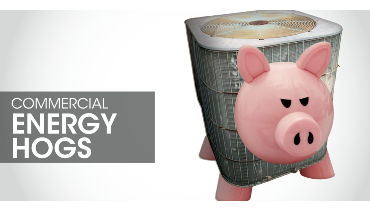Commercial Energy Hogs

In the U.S., energy use is divided into four sectors: residential, commercial, industrial, and transportation. Just as in our homes, commercial businesses utilize energy similarly, from lighting to electronics, appliances, and commercial cooling.
A rising need
According to The National Academies of Science, Engineering, and Medicine 2014 figures, 41% of all energy consumed in the U.S. went toward powering homes and commercial buildings. The energy consumption in these sectors – and others – is only expected to rise over the next 20 years – to the tune of 13%. During this same time period, global consumption is expected to rise 44%, significantly taxing natural resources.
Consuming current
Commercial establishments include a broad array of facilities whose energy needs vary, including offices, stores, schools, hotels, medical facilities, sports arenas, places of worship, government facilities, and other public and private organizations. Of the energy consumed by this sector, over half is attributable to commercial cooling and lighting, with nearly all of it is provided by electricity (53%) and natural gas (39%).
Who’s using it?
According to the 2008 U.S. Department of Energy Energy Efficiency and Renewable Energy Report:
- Office buildings 19%
- Retail and mall 18%
- Schools 11%
- Healthcare 8%
- Warehouse/storage 7%
- Lodging 7%
- Food service 6%
- Food sales 5%
- Public assembly 5%
- Service 4%
- Places of worship 2%
- Public order and safety 2%
What’s consuming the most energy in commercial buildings?
According to the U.S. Energy Information Administration’s 2012 Commercial Buildings Energy Consumption Survey:
- Space heating 25%
- “Other” 13%
- Lighting 10%
- Refrigeration 10%
- Ventilation 10%
- Commercial cooling 9%
- Computers/office equipment 8%
- Cooking 7%
- Water heating 7%
Staunching the flow
Though the need for energy is rising, U.S. consumption amounts could be far worse. As minimum efficiency standards have been implemented in various arenas, the consumption needs of equipment and products that use energy have declined considerably. State and national appliance efficiency standards in the 1980s have realized dramatic improvements in a host of appliances, not the least of which include former gluttons like air conditioners, water heaters, and refrigerators. Advancements in lighting technology have also greatly contributed to reducing energy needs.
Energy performance programs aiding the commercial sector include:
- Energy Star
Introduced by the Environmental Protection Agency in 1999, the Energy Star label certifies not only high efficiency appliances, but highly efficient buildings. Commercial spaces achieving a 75 (out of 100) or higher label use on average 35% less energy than similar buildings, and are themselves eligible for the Energy Star Label. - LEEDS
The Leadership in Energy and Environmental Design rating system was developed by the U.S. Green Buildings Council to promote a whole-building approach to sustainability through sustainable site development, materials selection, energy efficiency, water savings, and indoor environmental quality, with ratings ranging from LEED certified (lowest) to LEED Platinum.
Commercial cooling costs getting out of hand? Boost efficiency, keeping your business and the planet green with the help of Aire Serv®. Learn how today.
 Click to call
Click to call


